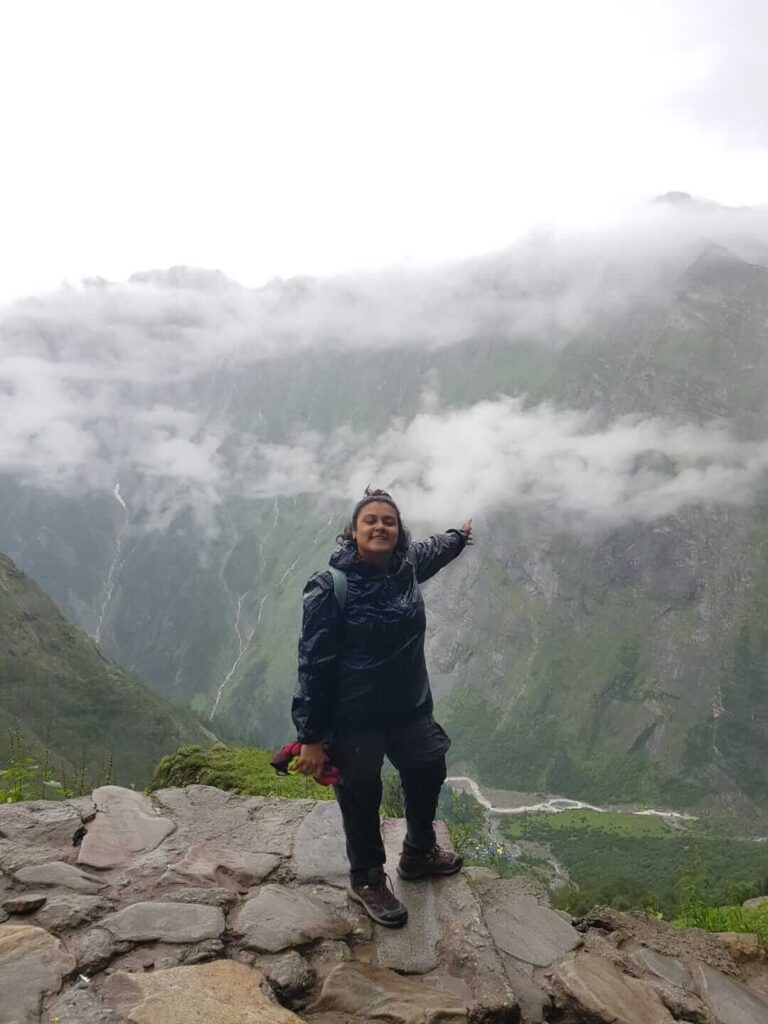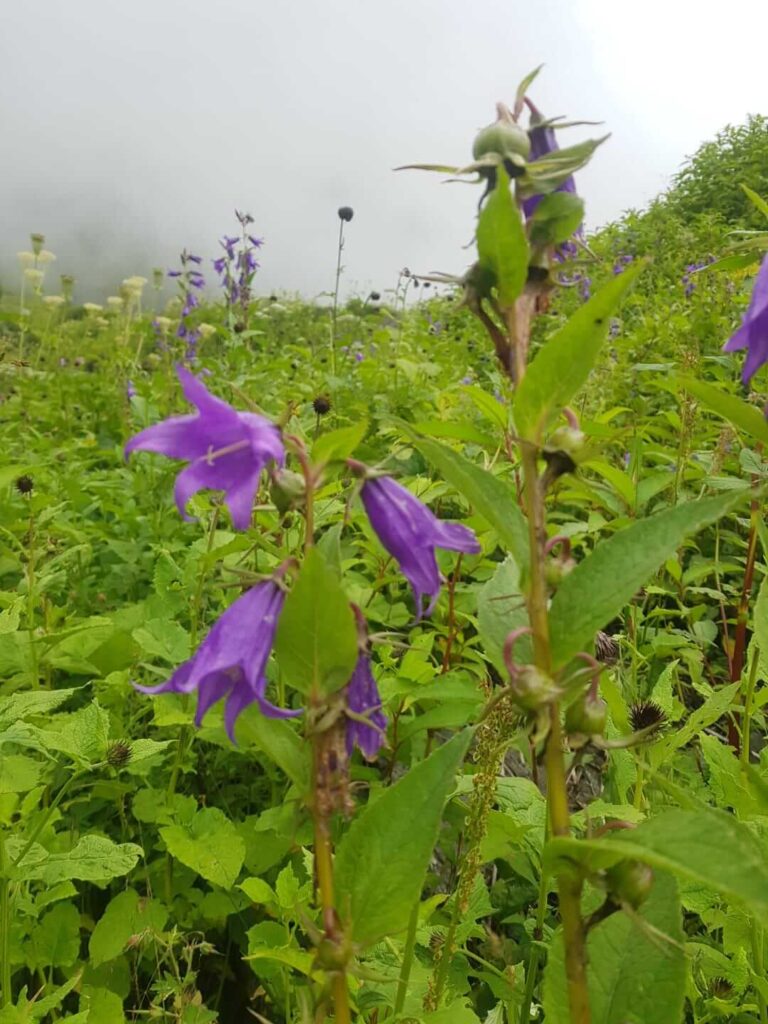As far as I can remember, it was in the first half of 2014. Images of the Valley of Flowers caught my attention on a social media platform. The images looked so stunning that I made a promise to myself that someday I would embark on this trek. Eight years, I’m here to narrate the experience of the trek.
Monsoon is considered the best time to visit the Valley of Flowers. Simply, because of the peek-a-boo of the passing clouds, the lush greenery carpeting over the mountains like fine velvet, the overflowing waterfalls and the gushing river almost singing the songs of monsoon, there can’t be another better time. Also, this is the time where the flowers in the Valley bloom leaving one in an astounding joy.

The base city of the trek Is Joshimath which is about 270 kilometres away from Haridwar. One can easily reach Delhi and take an overnight train to Haridwar and then a day journey, best started early. The route from Haridwar passing through Rishikesh with the river Ganga running parallel upto Rudraprayag has welcoming views of mountain ranges. While the journey with its curves and turns picks up on elevation, the scenery only keeps getting better. Passing through National Highway 7, the road is prone to plenty of landslides and hence leaving early through the day gives one an added benefit of reaching Joshimath by evening.
Waking up to the tall mountains with piercing clouds at morning hours at the homestay in Joshimath was a delight to sore city eyes. The start point of the trek is Govind Ghat, about an hour’s journey from Joshimath. All vehicles stop at the bridge before Govindghat, after which only the local sumos ply trekkers to the start point of the trek. Remember Ghangaria at the back of your head as it is the major stop over or base point for both the Valley of Flowers trek and the revered Gurudwara of Hemkund Sahib.
The trek from Govindghat to Ghangaria is picturesque and the pavements are well built. The trail runs parallel to the river and at many points makes you feel like you are entering an enchanted forest. There are several eateries on the way that serve snacks like maggi, fresh lime juice, etc. Surprisingly there are also public toilets that levy a nominal charge. Due to the footfall of pilgrims visiting the revered Gurudwara, the main trail of reaching Govindghat is well developed. Half way through the distance of the trek, a major stop over for trekkers is near the massive bridge river crossing. There are small eateries that serve piping hot dal, rajma, and rice for the tired trekkers and pilgrims alike. Standing on the bridge with light splashes of the roaring river makes one feel that trekking is indeed an activity that helps us reconnect with nature.
Post the bridge, the trek gets a little steep. The best way is to keep walking to keep up the momentum. Horses are also available for trekkers/ pilgrims who find it hard to trek. It is always advised to avoid wearing earphones/ headphones while trekking as horses often dangle their way and although rare, an unannounced danger like landslide or rock falling can be avoided. Govindghat to Ghangaria takes about 4-6 hours depending on the trekking speed. Ghangaria is the base camp and the temperature generally drops in the evening. Although it may seem a bit chaotic with all the eateries and homestays, the view from Ghangaria looks up to tall mountains with sharp peaks and will make you feel marvelled.

The next day, we headed to Valley of Flowers and started trekking at 7 AM with our packed lunches. Did you know that the Valley of Flowers was discovered accidentally by three lost British soldiers led by Frank Smythe in 1931. Since it is a World Heritage Site and is in the UNESCO World Network of Biosphere Reserves, drones are not allowed. There are no eateries here to avoid trash being thrown. The starting point of the trek passes through a river crossing with a beautiful waterfall at the far end. While the trek is steep at many points, the scenery throughout keeps one engaged. Post the police checking to enter this reserve, a prominent point Is a bridge crossing and a gushing river sight. The entire scenery looks straight out of a movie.
The clouds move as fast as your eyes can catch. You’d have to pinch yourself because the majestic mountains here hold magic. The entire landscape is lush green with rare flowers catching your eyes. Crossing several streams , you’ll probably get a little soaked in the rain. That said, the charm does not wear off. As you reach the Valley of Flowers, you’ll see a carpet of varied colors of flowers. The layout of the Valley is unique, unlike one I’ve seen before. Stretching up to the North East of the Valley, one can sight a few glaciers if the clouds seem to cooperate. The valley has varied types of flowers such as orchids, poppies, primulas, marigold, daisies and anemone. The Blue poppy flower and the national flower of Uttarakhand known as the Brahmakamal which are an absolute rare sight can be spotted here. It is highly advised not to pluck any flowers. Since there are no food vendors, the place manages to remain pristine.
The trek back to Ghangaria feels slightly easier now that it is majorly a descend. The evening is spent relaxing from the day’s trek and hot cups of chai and snacks. While in the mountain, a practice I follow is to retire early to bed to catch up on ample and enough sleep.
The trek to Hemkund Sahib is an arduous one. Located at an elevation of 4160 metres, the trek easily takes up 5-6 hours of trekking. While some pilgrims also choose to go on a horse, the fun of making it up there is a different high. One must start the trek no later than 8 A.M. as the weather often tends to get bad. A raincoat is advisable to be carried as the mist intensifies as one progresses and catches up on the altitude. There are several shops on the way that serve chai, maggi and other snacks. Since all the raw material is brought to these shops using a donkey or a horse, the prices seem to be slightly expensive. If you luck out on the weather, this side of the trek presents magnificent views of the valley with snow covered peaks. One off-sight about the trek is the constant parade of the horses carrying pilgrims, so one must always stay watchful.
The Gurudwara closes by 2 P.M., hence taking less breaks turns out to be useful. There are several small streams on this trek. As one reaches closer there is a glacier underneath which a waterfall flows. It is borderline magical to have experienced this frozen glacier so closeby. The last bit of the Hemkund Sahib Gurudwara are steep stairs. There is another way around which is 1 km longer and meant only for horses. I climbed the stairs in a rush to make it to the Gurudwara, panting mercilessly and trying not to give up. After a strenuous hike, the view of the Gurudwara truly felt spiritual and overwhelming. The site of the Gurudwara is dedicated to Guru Gobind Singh, the tenth Sikh Guru, and also said to be the meditating place of God Lakshaman. There is an alpine lake which is almost crystal clear. Mist often hides the view of the lake with poor visibility. But there is a certain unexplainable calm and peace at this place. Visiting the Gurudwara too brings a positive energy.
There is also a small langer that serves piping hot khichdi to pilgrims and that source of warmth and love through the food is pure joy. There is also a small Lakshaman temple in the vicinity and the lake is surrounded by Brahmakamal plants. The beauty of the lake is a treat to the eyes and a visit to Hemkund Sahib will truly test your stamina and spirituality. The water from the lake is later said to be joining the river Ganga. Plastic bottles are available at the shops near Gurudwara to carry this pristine water back.

The trek back to Ghangaria definitely feels a lot easier since it is a descent. Trekking to the Valley of Flowers first and later to Hemkund Sahib on the following day is a good idea as the previous trek will improve your stamina. The return journey from base camp Ghangaria and later to Govindghat feels a bitter sweet one. Knowing that you’ve experienced this unparalleled beauty of this valley with countless memories and a sheer taste of raw natural beauty. The other end is having to go back to the bustling city life with tales and stories to tell. Valley of Flowers trek is one of the must visit treks on your Himalayan trek list. Not to forget, the innumerable dreamy Instagram photos with reminiscence of the journey.










